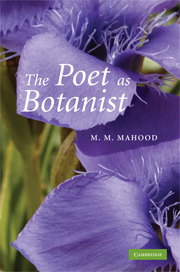Book contents
- Frontmatter
- Contents
- List of illustrations
- Acknowledgements
- A note on quotations
- Introduction
- 1 Primroses at Dove Cottage and Down House
- 2 Erasmus Darwin's feeling for the organism
- 3 Crabbe's slimy mallows and suffocated clover
- 4 John Clare: bard of the wild flowers
- 5 Ruskin's flowers of evil
- 6 D. H. Lawrence, botanist
- 7 Poetry and photosynthesis
- Index of persons
- Index of plants
3 - Crabbe's slimy mallows and suffocated clover
Published online by Cambridge University Press: 22 September 2009
- Frontmatter
- Contents
- List of illustrations
- Acknowledgements
- A note on quotations
- Introduction
- 1 Primroses at Dove Cottage and Down House
- 2 Erasmus Darwin's feeling for the organism
- 3 Crabbe's slimy mallows and suffocated clover
- 4 John Clare: bard of the wild flowers
- 5 Ruskin's flowers of evil
- 6 D. H. Lawrence, botanist
- 7 Poetry and photosynthesis
- Index of persons
- Index of plants
Summary
For a natural philosopher of the eighteenth century, botany could be an exotic and exciting pursuit. There was often the thrill of knowing that the seeds he propagated in his hothouse had been brought from the other side of the world, and the plants they grew into might prove spectacular in a number of ways. Or he might find himself nursing the inflorescence of a male palm throughout a nine-day journey from Leipzig to Berlin, in order to pollinate a female palm that had languished unfertilised for eighty years. But for the general run of English botanists at the beginning of the next century, many of them clergymen on modest stipends, the science was an altogether tamer business of distinguishing, identifying and recording the species and subspecies native to a small locality. The only excitement such a field naturalist could hope for was that, as he went about his parish duties, his eye might light upon some hitherto unrecorded grass or moss.
George Crabbe, like Erasmus Darwin a botanist and a poet, at first sight appears to conform to this more homely model. In fact, he is no more to be stereotyped as a botanist than, as poet, he is to be fitted into any of the traditional categories of literary history. Although younger than Darwin by a generation, Crabbe began to publish verse before the elder poet did, winning Dr Johnson's approbation for The Village as early as 1783.
- Type
- Chapter
- Information
- The Poet as Botanist , pp. 82 - 111Publisher: Cambridge University PressPrint publication year: 2008
- 1
- Cited by



